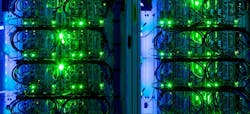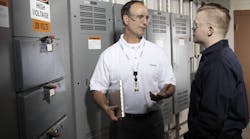In this week’s Voices of the Industry, Adam Kramer, Switch’s Executive Vice President of Strategy, explores what it really means for a data center to be green and the importance of sustainability.
ADAM KRAMER, Switch
We know that data runs the planet, which is why we want to ensure that data doesn’t ruin the planet. As leaders in the data center industry, we view our focus on sustainability through the lenses of leadership, commitment, transparency and advocacy.
In recent years, there’s been a global push to reduce carbon emissions and reduce energy consumption inside of the data center. As both consumers and companies demand accessibility to more data faster and with the greatest efficiency, it is becoming more challenging to deliver without acknowledging the significant amount of energy required to run it.
It is imperative that leaders in the data center industry address energy usage and its environmental impact. As the Internet of Things grows exponentially, so will the energy requirements of data centers around the world. It’s estimated that the same amount of electricity that was used to light the entire planet in 1985 is now being used to power edge user devices and the cloud.
The good news is users are demanding that data centers be powered by renewable energy sources, and this is helping to drive change. Today, many data center providers are claiming to be powered by renewable energy and even offering clients renewable energy credits (RECs) to offset their load. However, there is a major difference between companies purchasing only RECs to claim they are “green” versus companies like Switch, Google, eBay, Apple and others that are purchasing both RECs and the associated renewable energy. Only the latter truly impacts the proliferation of renewable energy and helps clean up the data center industry.
Driving change through action
For the last five years, Greenpeace has published its Clicking Clean report. The report identifies “green” data center providers and large enterprise users by measuring the percentage of their power derived from renewable energy, as well as a company’s public commitment to sustainability, transparency, energy efficiency efforts and advocacy. The report ultimately serves as a litmus test by which all companies evaluated can measure their commitment to renewable power and energy efficiency.
This has also been a great way for consumers to cut past a company’s marketing material to help them more accurately make a buying decision, and help shed more light on a major problem in the data center industry: greenwashing. Simply put, greenwashing is the act of companies claiming to be green and supporting renewable energy efforts, without actually doing so.
Sustainably running the internet is a commitment Switch’s Founder and CEO Rob Roy has cemented in every aspect of our company’s development and growth for the past 16 years. That’s why, in late 2015, we invited Greenpeace’s Clicking Clean lead author Gary Cook to visit our SUPERNAP Las Vegas campus so he could include the company in the 2016 report. We encourage other providers to do the same.
Additionality, locality and advocacy
One of the driving principles for the companies that adhere to the guidelines outlined in Clicking Clean is that they not only state their intentions to be 100 percent green, but more importantly, work to bring on new renewable energy resources (additionality) that are located within the electrical region where the power is being consumed (locality).
Nonetheless, the process of achieving additionality and locality is often times quite difficult because of the regulated energy environments that oversee all energy markets (even in a state that offers direct access, there is still heavy regulation surrounding the electrical grid and generation).
Without strong advocacy from companies who believe in additionality and locality, many markets around the country would still be without an option for renewable energy.
Our story illustrates the challenges of this process. When Switch first pursued going 100 percent green in southern Nevada in late 2013, there was no green energy tariff to facilitate that move. That is why Switch, very publicly, became the first company in Nevada to have a direct access case heard in front of the Public Utilities Commission of Nevada (PUCN).
Through the process, we worked with local utility NV Energy to develop a green rider tariff in southern Nevada (similar to the one developed with Apple and NV Energy in northern Nevada). This allowed us to enter into 20-year power purchase agreements (PPAs) with NV Energy and First Solar to construct Switch Station 1 and Switch Station 2; 180 MW of new renewable generation (additionality) to Nevada (locality) to serve 100 percent of Switch’s load both for its Las Vegas campus and Tahoe Reno campus.
It also allowed Switch to become 100 percent renewably powered as of January 1, 2016, by purchasing bundled renewable energy (RECs and power) from NV Energy while our new solar facilities are being built.
When data centers take the lead in this process, it helps make other businesses more sustainable. The city of Las Vegas is now using the same green tariff to make itself 100 percent renewably powered.
Making sure data doesn’t ruin the planet
All data center providers and large enterprise users have the responsibility to make sure they are powering their data center on 100 percent renewable power. It doesn’t have to happen overnight but the work to get there needs to start now. While it is admirable that data center providers want to offer their clients renewable energy credits to offset their energy footprint, at the end of the day that is all marketing and no action. Data centers should ensure that they are advocating for new renewable generation to build in the region where they generate power. As an industry that is quickly becoming the largest power consumer in the world, we have a responsibility to ensure we’re running the internet in the most sustainable manner possible.
Submitted by Adam Kramer, Switch’s Executive Vice President of Strategy. Connect with Adam on LinkedIn. Founded by Rob Roy in 2000, Switch is a transformational technology idea engine and platform for all of his sustainability-focused patents and differentiated technologies. Switch’s SUPERNAP Tier IV Gold-based data centers are the physical manifestation of Rob Roy’s patents and Switch’s revolution in the technology infrastructure industry.





